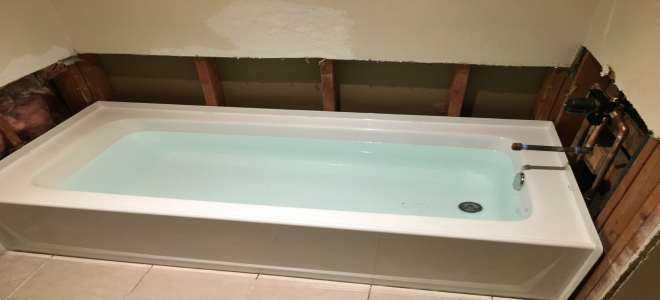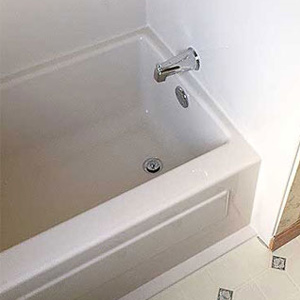A Beginner's Guide to Plumbing for Bathtub Installation
A Beginner's Guide to Plumbing for Bathtub Installation
Blog Article
Nearly everybody maintains their own conception about Installing A Bathtub.

Setting up a bath tub isn't specifically rocket science, yet it does call for solid plumbing, carpentry, and also sometimes, tiling abilities. Replacing an old bathtub with a new one is additionally a reasonably difficult job. If the old tub is easily accessible, the job can relocate quickly; if you have to open a wall to remove the old tub as well as place the brand-new bathtub, the task is a lot harder. In either instance, the task is within a residence handyman's skills, although you will need an assistant to vacate the old tub and also set in the brand-new one. Make certain you have certified on your own for the work as well as fit trying it. Rather than working with a professional to take over a halfway-completed task, it is better to take into consideration utilizing one prior to you begin. Opportunities are you might require a professional plumber to make tube connections.
This short article will certainly assist you set up a brand-new bath tub in your bathroom if you have actually already bought a new bathtub and also don't need to alter the arrangement of your previous water supply pipes.
Your tools as well as material checklist ought to consist of the following:
Removing Old Touches
If you require to change old taps with new ones as a part of your setup, after that the first thing you must do is disconnect the water system. After doing so, activate the faucets to drain pipes any type of water remaining in the system. The procedure of getting rid of the existing faucets can be rather troublesome due to the restricted access that is commonly the instance.
Utilize a container wrench (crowsfoot spanner) or a faucet tool to reverse the nut that attaches the supply pipelines to the faucets. Have a cloth all set for the continuing to be water that will certainly come from the pipes. As soon as the supply pipelines have actually been gotten rid of, use the exact same device to loosen the nut that holds the faucets onto the bath/basin. You will certainly need to quit the solitary faucets from transforming throughout this process. When the faucets have been gotten rid of, the holes in the bath/basin will have to be cleansed of any type of old securing compound.
Before carrying on to fit the brand-new taps, compare the pipe connections on the old faucets to the new faucets. If the old faucets are longer than the new taps, then a shank adapter is required for the new faucets to fit.
Suitable New Touches
If the tails of the new taps are plastic, then you will require a plastic connector to stop damages to the string. One end of the port fits on the plastic tail of the faucet and also the various other end provides a link to the current supply pipelines.
If you require to fit a monobloc, after that you will require lowering couplers, which attaches the 10mm pipeline of the monobloc to the standard 15mm supply pipe.
Next, place the tap in the mounting hole in the bath/basin guaranteeing that the washers are in place in between the tap and also the sink. Protect the faucet in position with the producer provided backnut. As soon as the tap is firmly in place, the supply pipes can be linked to the tails of the faucets. The taps can either be connected by utilizing corrugated copper piping or with typical tap ports. The former type must be attached to the faucet finishes first, tightening just by hand. The supply pipes can later be attached to the other end. Tighten both ends with a spanner after both ends have been linked.
Mounting the Bath tub
Making use of both wooden boards under its feet, position the tub in the required setting. The wood boards are useful in equally spreading out the weight of the bath tub over the location of the boards instead of concentrating all the weight onto four little points.
The following objective is to ensure that the bath tub is leveled all round. This can be achieved by examining the level as well as adjusting the feet on the bathtub up until the spirit level reads degree.
To set up faucets, fit all-time low of the outermost adaptable faucet port to the suitable supply pipe by making a compression sign up with; after that do the exact same for the other faucet.
Turn on the supply of water and examine all joints and also new pipework for leaks and tighten them if needed. Fill up the bath tub and additionally check the overflow outlet and the normal electrical outlet for leaks.
Ultimately, fix the bath paneling as defined in the producer's instruction manual. Tiling and also sealing around the tub should wait till the bath tub has actually been utilized at least once as this will resolve it into its last setting.
Getting ready for the Installment
Firstly, the sustaining framework supplied with the bath needs to be fitted (if called for) according to the supplier's directions. Next off, fit the taps or mixer to the bath tub. When fitting the tap block, it is essential to make sure that if the tap features a plastic washer, it is fitted in between the bath and the faucets. On a plastic bath, it is also sensible to fit a supporting plate under the faucets device to stop stress on the bath tub.
Fit the versatile tap adapters to the bottom of the two faucets using 2 nuts and also olives (sometimes provided with the bathtub). Fit the plug-hole electrical outlet by smearing mastic filler round the sink electrical outlet hole, and afterwards pass the outlet with the hole in the bath. Utilize the nut provided by the maker to fit the plug-hole. Check out the plug-hole electrical outlet for an inlet on the side for the overflow pipeline.
Next off, fit the end of the adaptable overflow pipe to the overflow electrical outlet. After that, screw the pipeline to the overflow face which should be fitted inside the bathroom. Make certain you use every one of the supplied washers.
Attach the trap to the bottom of the waste outlet on the bathtub by winding the string of the waste outlet with silicone mastic or PTFE tape, and also screw on the trap to the electrical outlet. Connect all-time low of the overflow tube in a comparable manner.The bathroom need to now be ready to be fitted in its final placement.
Tiling Around the Tub
In the location where the bath fulfills the tile, it is needed to secure the accompanies a silicone rubber caulking. This is very important as the fitting can move enough to fracture a rigid seal, creating the water to penetrate the wall between the bathroom as well as the tiling, bring about complications with dampness and also feasible leakages to the ceiling below.
You can choose from a variety of coloured sealers to assimilate your components and also fittings. They are offered in tubes and also cartridges, and are capable of sealing spaces as much as a size of 3mm (1/8 inch). If you have a larger space to load, you can load it with twists of soaked paper or soft rope. Bear in mind to constantly fill the bathtub with water prior to securing, to permit the activity experienced when the bathtub remains in use. The sealant can split fairly early if you do not think about this movement prior to securing.
Additionally, ceramic coving or quadrant ceramic tiles can be made use of to edge the bathroom or shower tray. Plastic strips of coving, which are easy to use and cut to size, are additionally easily offered on the marketplace. It is a good idea to fit the floor tiles utilizing water-resistant or water resistant sticky and cement.
Bathtub Installation
How Important Is A Bathtub To Your Home?
High-quality baths, showers, and other bathroom updates are necessary when considering a smart investment in your home. It’s a room that you go to every day and one that is constantly being used by guests.The bathroom is one of the top trafficked rooms in a home and also one of the most valuable in terms of home resale.
Install Piping Before Tub
You will be using your existing drain and waste vent system, but pipes required include the hot and cold water supply lines and a pipe leading to a shower head. A mixing valve and shower head are also needed. Air chambers may be required.
Position the Tub
Lower the tub into place so that the continuous flange fits against the wall studs and rests on 1’x4' or 2’x4' supports. Anchor the tub to the enclosure with nails or screws inserted through the flanges into the studs.
NOTE: Remember, bathtubs and shower stalls may require support framing. A bathtub filled with water is extremely heavy, so check building codes and framing support before installing the tub.
Assemble Drain Connections
Assemble the bathtub drain connections by connecting the tub overflow with the tub drain above the trap, not beyond it. The trap will have a compression fitting that screws over the arm of the overflow assembly.
Place a Pipe For the Shower Head
First, locate a brass female threaded winged fitting and attach it to a framing support via a screw or a nail. Then run a pipe up the wall for the shower head. Sweat or solder the other side of the brass fitting to the top of the pipe.
Attaching Hot and Cold Water Lines
Attach your water lines for both hot and cold by sweating these directly into the hot and cold ports of the mixing valve. The mixing valve will be how water enters the tub’s system, not by the pipes themselves.
Install the Spout
Extend a piece of 1/2 inch pipe, or whichever length is specified in the manufacturer’s instructions, for the tub spout. Sweat on a male threaded fitting at the end of the pipe or use a brass nipple of the proper length and a 1/2 inch cap.
NOTE: At this point you should have your rough-in plumbing work inspected before proceeding further.
Check For Leaks
Restore the water pressure and check the drain connection and the supply pipes for any sign of leaking.
estore the Bathroom Wall
Replace the wall with moisture-resistant drywall as a base for your wall covering. Seal the joints between the wall and your new tub with silicone caulk as protection against water seepage.
https://www.berkeys.com/2016/12/02/bathtub-installation-dallas/

We were brought to that write-up about How to Install a Bathtub from an associate on a different web blog. Sharing is nice. You never know, you may just be helping someone out. I love reading our article about Tools You Need to Install a New Bathtub .
Best results? Dial! Report this page